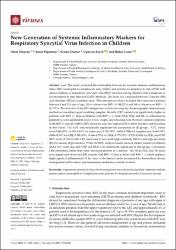New Generation of Systemic Inflammatory Markers for Respiratory Syncytial Virus Infection in Children
Künye
Okuyan, Ö., Elgörmüş, Y., Dümür, Ş., Sayılı, U., & Uzun, H. (2023). New Generation of Systemic Inflammatory Markers for Respiratory Syncytial Virus Infection in Children. VIRUSES-BASEL, 15(6). https://doi.org/10.3390/v15061245Özet
Aim: This study evaluated the relationship between the systemic immune-inflammatory index (SII), neutrophil-to-lymphocyte ratio (NLR), and platelet-to-lymphocyte ratio (PLR) with clinical findings of respiratory syncytial virus (RSV) infection among children with a diagnosis of lower respiratory tract infection (LRTI). Methods: The study was conducted between 1 January 2020 and 1 January 2022 in a pediatric clinic. This retrospective study included 286 consecutive patients between 0 and 12 years of age, 138 of whom were RSV (+) (48.25%) and 148 of whom were RSV (-) (51.75%). The detection of the RSV antigen was carried out using the chromatographic immunoassay method on nasopharyngeal swabbing samples. Results: CRP content was significantly higher in patients with RSV (+) than in children with RSV (-), while NLR, PLR, and SII, as inflammatory parameters, were significantly lower. Fever, coughs, and wheezing were the most common symptoms in the RSV (+) groups (100%). RSV infections were the highest in November, October, and December, in that order. The AUC was statistically significant for parameters in all groups. AUC values were 0.841 (95%: 0.765-0.917) for leukocytes, 0.703 (95%: 0.618-0.788) for lymphocytes, 0.869 (95%: 0.800-0.937) for CRP, 0.706 (95%: 0.636-0.776) for NLR, 0.779 (95%: 0.722-0.836) for PLR, and 0.705 (95%: 0.633-0.776) for SII. CRP was found to have both high sensitivity (80.4%) and high specificity (82.4%) among all parameters. While the ROC analysis results showed similar results for children under two years old, only CRP and NLR were statistically significant in this group. Conclusion: CRP performed better than other blood parameters as a marker. The NLR, PLR, and SII index were significantly lower in LRTI patients with RSV (+) than in those with RSV (-), which implies a higher grade of inflammation. If the cause of the disease can be determined by this method, disease management will be easier, and unnecessary antibiotics could be avoided.

















